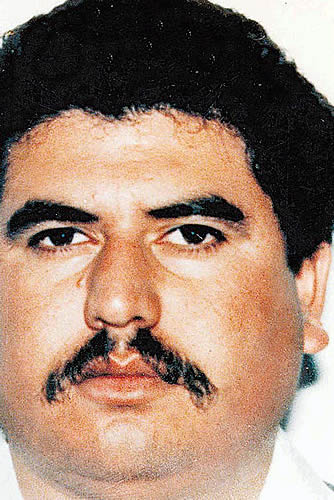<Back to Index>
- Leader of the Juárez Cartel Vicente Carillo Fuentes, 1962
PAGE SPONSOR

Vicente Carrillo Fuentes (born October 16, 1962) is a Mexican drug lord who headed the Juárez Cartel in Mexico, which controls one of the primary transportation routes for billions of dollars worth of illegal drug shipments entering the United States from Mexico annually. He was among Mexico's most powerful and most wanted drug lords until his arrest in 2014.
The Juárez Cartel was founded by his brother Amado Carrillo Fuentes following the death of Pablo Acosta Villarreal. Vicente was born to Vicente Carrillo and Aurora Fuentes in Jerez de Garcia Salinas, Zacatecas. He was the third of six brothers: Cipriano, Amado, Vicente, José Cruz, Alberto and Rodolfo. Vicente also has six sisters. All are nephews of Ernesto Fonseca Carrillo.
Cipriano Carillo Fuentes died in the mid 1980s by gunshot under mysterious circumstances. Amado began in the drug business under the tutelage of his uncle and eventually formed the Juárez Cartel by 1993. Amado brought in his brothers and eventually his son Vicente Carrillo Leyva, who was arrested on April 1, 2009.
When Amado died on July 3, 1997 following complications from plastic surgery, a brief turf war began in Juarez over the leadership of the cartel. Vicente would emerge as the victor after defeating the Muňoz Talavera brothers for control of the cartel. Vicente formed a partnership with Juan José Esparragoza Moreno, his brother Rodolfo Carrillo Fuentes, his nephew Vicente Carrillo Leyva, Ricardo Garcia Urquiza and the Beltrán Leyva brothers. He kept in service several lieutenants formally under his brother, such as "El Chacky" Hernandez.
The organization was in flux by the time Vicente took control of the cartel and the death of Amado created a large power vacuum in the Mexican underworld. The Arellano Félix brothers became the most powerful organization during the 1990s while Vicente was able to avoid direct conflict and increase the strength of the Juárez Cartel. The relationship between the Carrillo Fuentes clan and the other members of the organization grew unstable towards the end of the 1990s and into the 2000s. In 2001 after the escape from prison by Joaquín Guzmán Loera, many of the Juárez Cartel members defected to Guzmán's Sinaloa cartel.
In 2004 Rodolfo Carillo was killed outside of a movie theater allegedly at the behest of Guzmán Loera. Vicente Carrillo responded by having Guzmán Loera's brother "El Pollo" assassinated in prison. This sparked off a turf war; however, it seemed that the war between the two was on hold during 2005 and 2006 because the Sinaloa Cartel was engaged in a vicious war with their rival, the Gulf Cartel. During this time, the leadership of the cartel was between Vicente Carrillo and Ricardo García Urquiza, who was arrested in November 2005. The cartel had become factionalized between the groups loyal to the Carrillo family and the groups loyal to Juan José Esparragosa Moreno and Guzmán Loera's Sinaloa Cartel.
The Juárez Cartel, under the control of Vicente Carrillo Fuentes and his nephew Vicente Carrillo Leyva, was placed under a large degree of pressure following the "House of Death" case, in which the organization was penetrated by law enforcement, but was corrupted by the fact that the informant participated in murders. In 2008, 200 murders occurred in the first three months and it appeared that the war between the Sinaloa Federation and the remnants of the Juárez Cartel was back on. President Calderón sent thousands of troops to Ciudad Juárez. The Juárez Cartel, at one time the most powerful in Mexico, is a shadow of its former self.
Carrillo Fuentes is currently at large and is charged in a forty - six
count indictment in the Western District of Texas with continuing
criminal enterprise, importation and possession with intent to
distribute cocaine and marijuana, conspiracy to import and possess with intent to distribute cocaine and marijuana, as well as with money laundering,
tampering with a witness, ordering the intentional killing of
individuals to prevent communication of information by them to U.S. law
enforcement, and murder in furtherance of a continuing criminal
enterprise. The U.S. Department of State was offering a reward of up to
$5 million USD for information leading to the arrest and/or conviction of Vicente Carrillo Fuentes.
Carrillo Fuentes was arrested in a joint operation by the Mexican Army and Federal Police in Torreón, Coahuila
on 9 October 2014. He was then sent to Mexico City and transferred to
the federal installations of SEIDO, Mexico's anti-organized crime
investigatory agency, where he gave a formal declaration. Two days
later, he was formally charged with drug trafficking and organized crime
offenses. On 14 October 2014, Carrillo Fuentes was transferred to the Federal Social Readaptation Center No. 2,
a federal maximum security prison (commonly referred to as "Puente
Grande"), in Jalisco state. That same day, he was formally charged by a
federal court in Jalisco for violating Mexico's Federal Law of Firearms and Explosives.